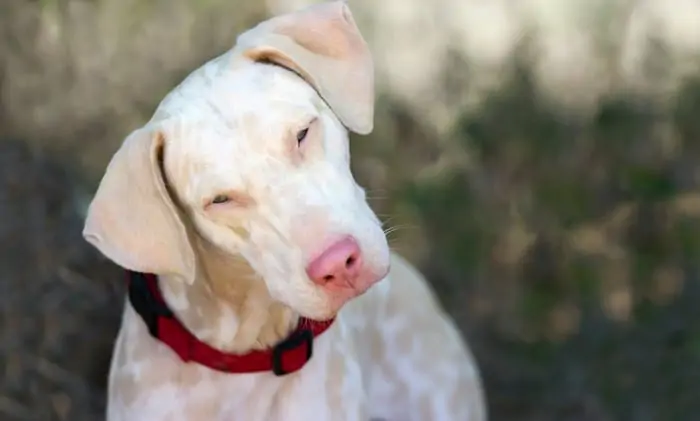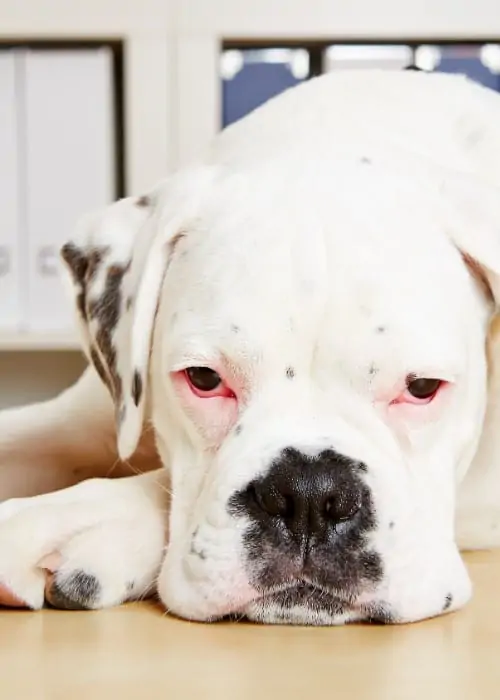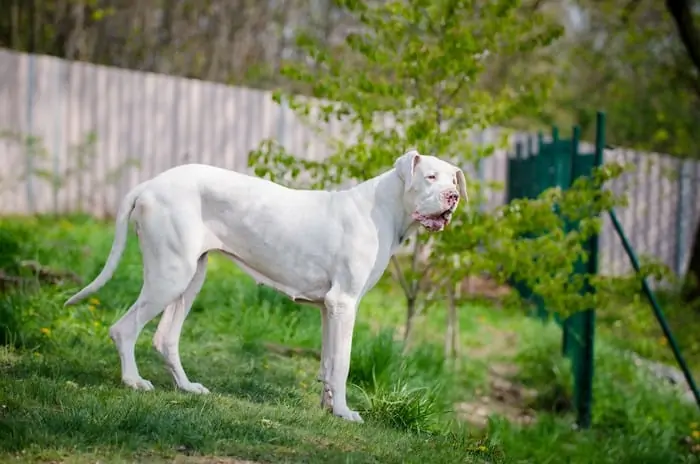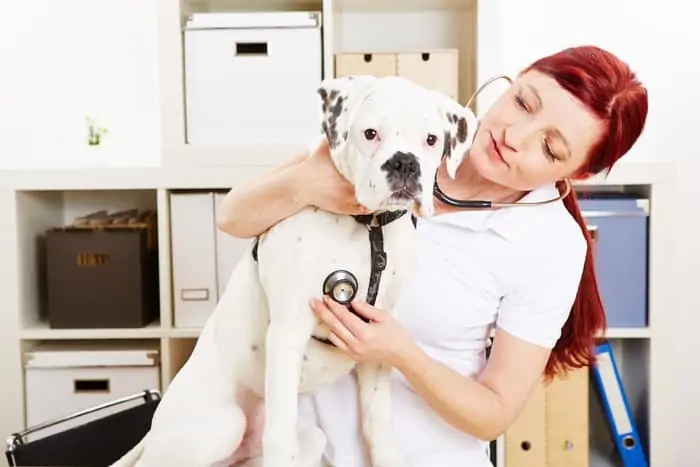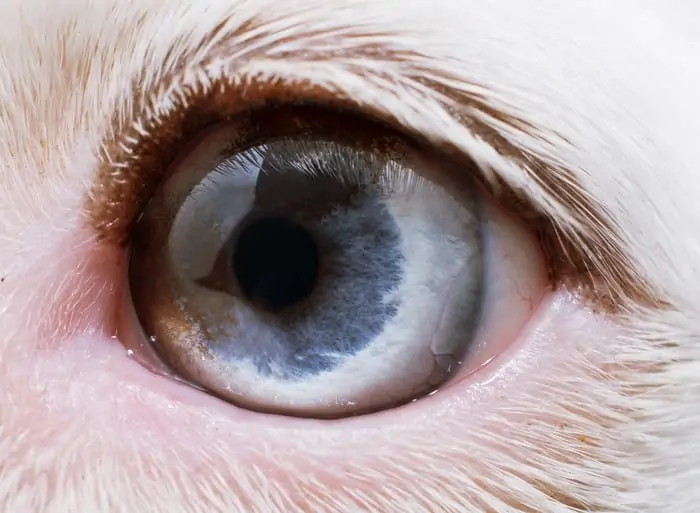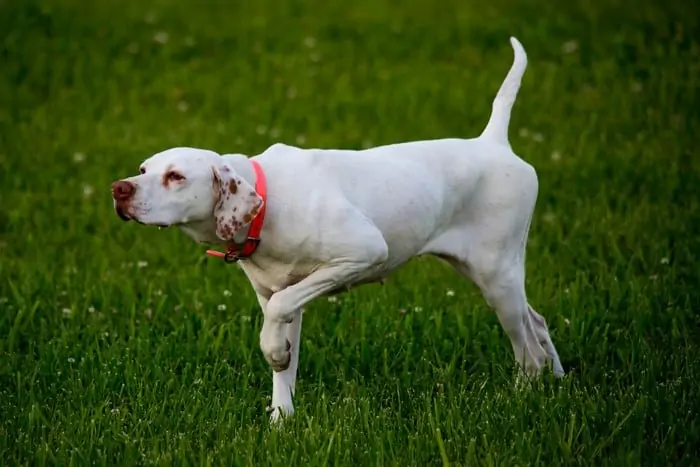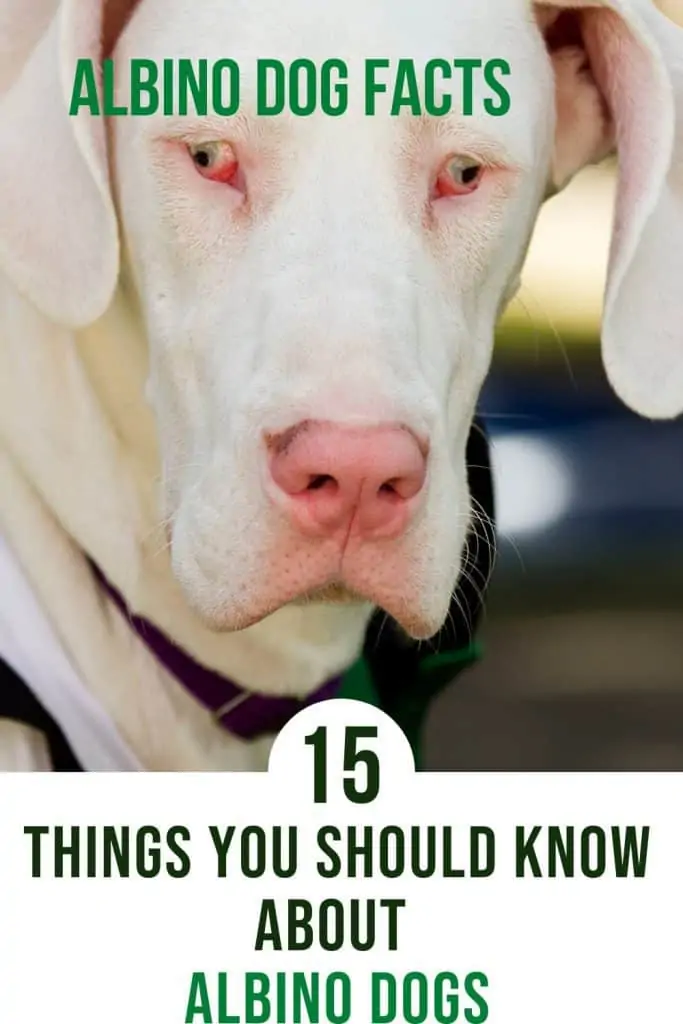Like most dog parents, you’ve probably seen an albino dog. You might be thinking about getting an albino dog, or you just want to have more information about this unique and rare condition.
Either way, we have you covered.
In this post, we are going to cover everything you need to know about this rare and unique condition. You’ll leave this post knowing the most important albino dog facts.
Contents
Albino Dogs Are Rare
Albino dogs are rare. Even dogs that show some of these characteristics are not true albinos and you will be lucky to see one.
Complete albino dogs with no melanin pigment are rare. What you’ll see is a variation of albinism in some breeds. Even vets don’t agree about some of these variations that exist in the first place.
The first case of albinism was discovered in Doberman Pinschers in 1976. The dog was called Padula’s Queen Sheba (“Sheba”). Sheba’s parents (Rasputin VI, AKC registration no. WD180171) and (Dynamo Humm, AKC, registration No. WD 2782225) both had the same homozygous recessive gene responsible for albinism. Chances are if you have seen an albino Doberman Pinschers, it must have been a descendant of Sheba.
Since then, the albino Doberman pinscher has become popular because of their novelty. Some breeders also go to the extent of exploiting these breeds and even calling them “a rare white Dobermans” to make more money.
The reality is albino dogs have serious health challenges such as photophobia and should not be bred.
Different dogs will have different coat patterns which most dog parents will confuse with albinism. For instance, merle and piebald patterns look similar to albino. You will see these patterns in Australian Shepherds, Great Danes, Dachshunds, and collies.
The marlie pattern is an inherited trait. That means a dog has to receive at least this trait from one parent to have this coat.
Albinism is different because the two dogs must have the exact two copies of the recessive gene to give birth to an albino.
If you are having a problem differentiating these dogs based on the coat color, you will need to check the family tree or do genetic testing.
Lastly, albinism is rare because dogs that have it don’t live for that long to reproduce. That said, if you have seen a true albino, count yourself lucky.
Albinism in Dogs Come in Different Ways
A partial albino dog has less melanin.
Let’s agree on one thing.
It’s hard to see a true albino. In most cases, you will see partial albinism or leucistic that’s present in some breeds. Without a thorough medical examination, you can’t know if a dog is a true albino or not.
The conditions show up in different ways and proper examination is needed. For instance, the main difference between true and partial albino dogs will be the melanin pigmentation.
A true albino dog will lack the melanin protein in its body and the difference is noticeable in the skin, eyes, nose, and even its fur.
A partial albino dog will choose to retain some melanin protein. The small amount of melanin is enough to make the dog have little coloration in different parts of the body. The coloration is noticeable in the dog’s nose, stomach, eyes, skin, and even the coat.
Leucism is mistaken for albinism although both share similar characteristics. They share the level of melanin in their D.N.A.
The only difference that distinguishes them is the health issues. A leucistic dog won’t have health issues like an albino dog although it will have less amount of melanin in their body.
In a true albino dog, blood vessels show up because of melatonin deficiency in the iris and retina. That is why the color of a dog’s eyes is light blue or translucent.
A leucistic dog will have slightly blue eyes but hard to recognize unless you do two medical examinations.
Therefore, it is so easy to confuse these dogs that misdiagnosis happens often. You will have to make sure the vet doing the genetic analysis has to have experience in leucism and albinism. Otherwise, the risk of getting a wrong diagnosis is high and can lead to the wrong treatment.
Albinism Shows Up in Certain Breeds
The great white Dane is an example of a tyrosinase-positive breed.
The albino dominant trait is common in certain breeds of dogs. Michigan State University has a study that shows albinism is more present in Doberman Pinschers. That discovery caught most veterinarians and breeds by surprise.
The study went on to say that the same mutated gene which causes albinism in humans is the same one found in the Doberman Pinscher breed. An albino Doberman will have a white or light-colored coat, pink noses, and lips.
Other forms of albinism called tyrosinase-positive shows up in dogs that exhibit whitening but have the melanin pigment.
Tyrosinase-positive is common in German shepherds, west highland white terrier, Great Dane, Dalmatians, Collies, and Pugs. Albino pugs have a colorless iris. What that means is that their iris doesn’t appear black or dark brown. Since they don’t have melanin in the cornea area, their blood vessels are visible from a distance.
TYR Gene is the Cause of Dog Albinism
The TYR gene manufactures tyrosinase which produces melanin on the skin.
A dog is called an albino when it lacks the tyrosinase enzymes that produce melanocytes. The role of melanocytes is to manufacture melanin protein which plays a huge role in our skin. When the enzymes are completely absent or little, the result is a complete or partial albino.
The TYR gene manufactures tyrosinase and it’s located in the melanocyte cell in the skin. When mutations take place, the TYR gene is affected leading to a production of little or lack of tyrosinase enzymes.
The mutation takes place only when you have two healthy dogs with a recessive gene that mate to produce a tyrosinase-negative offspring. One thing scientists and vets are sure of is that albinism won’t happen if one parent has a recessive gene and the other doesn’t have. This also explains why true albinism is so rare in dogs.
Only Medical Examination Can Tell You If A Dog is an Albino
Only a medical check can tell you if a dog is an albino. The test has to be done by a qualified vet.
You’ve noticed that albinism comes in different variations. It is these variations that cause lots of confusion. Chances of you confusing a white dog, leucistic dog, and true albino dog are so high. That’s why a proper medical examination is needed.
Before you do that make sure the vet you are consulting with has enough experience in this matter to avoid possible misdiagnosis.
A vet who studies genetic science will do a thorough genetic analysis to identify the SLC45A2 gene. The gene is present in Doberman Pinschers and other small dog breeds. If the results are positive, then the dog is an albino.
The bad news is, veterinary scientists, don’t know the exact genetic carriers of albinism in dogs. Alternatively, vets can also work with qualified breeders to establish the dog’s family history. That way, they will know if a dog is an albino or not.
Since most scientists don’t know the appropriate genetic markers to identify albinism, they will rely on visible characteristics to make their decision besides testing.
Finally, never trust anyone who tells you that you have an albino dog blindly. That’s because albino dogs are rare and we don’t have a reliable way of diagnosing or testing the condition.
Albino Dogs Have a Short Lifespan
Losing a dog is a painful experience. It’s even harder to accept that your dog won’t be normal and their lifespan is short. Such is the case of an albino dog.
Their lifespan is short because they have a weak immune system and other underlying health challenges. When a dog has a short lifespan, that means it won’t get a chance to mate with other dogs.
Camouflage plays a huge role in an animal’s life. They use it to defend themselves, hunt and hide from potential prey. Without the color pigmentation, animals don’t have their camouflage and won’t stand out.
That said, albino animals will have to be kept away from the rest of the animals when mating season comes. Since they don’t mate often, you will have a few albino dogs around.
But that’s not all, you can improve and prolong their lifespan with the quality of care you provide them.
Albino Dogs Are Susceptible to Skin Disorder
Exposure to direct sunlight damages the dog’s skin. That happens because albino dogs do not have melanin pigment on their skin. As we have said earlier, melanin shields the skin from harmful ultraviolet rays from the sun.
The same statement applies to dogs. When an albino dog is constantly exposed to these UV rays sunburn occurs. Sunburn in dogs causes acute pain and long term health issues. Dogs with sunburn will have symptoms like redness of the skin, blistering, and pain during movement.
Since these dogs have a compromised immune system, their skin won’t fight free radicals which means they are at a higher risk of getting melanoma.
Melanoma is a form of skin cancer that happens to both humans and dogs. The exact cause of melanoma in dogs is unknown but in humans, it is ultraviolet rays.
Dogs researchers believe the cause is albinism or any genetic disorder. Melanoma in dogs comes in four different ways: cutaneous, ocular oral, and subungual melanoma.
Albino Dogs Have Eye-Problems
Albino dogs have light-colored eyes. When exposed to light their vision is impaired
Their eyes are light as opposed to black or brown. Since their eyes are light-colored they cannot filter out excess light due to lack of melanin. That’s why the central part of the dog’s eyes called the retina is susceptible to damage.
Macular degeneration is a condition that affects vision impairment in dogs. Macular is a small part of the retina that differentiate details and colors. That said, the chances of your dog’s vision being impaired are too high.
If an albino dog is not taken care of well, they can be blind. When a dog is blind, they may have problems walking around and they can injure themselves.
But light is not the only cause. These dogs have undeveloped lenses and retinas which also cause poor vision and can make the dog blind. Most albino dogs will have small and deformed eyes. It’s impossible to cure these deformities because they are all connected to albinism.
They Have a Pinkish Appearance
The physical appearance of albino dogs might resemble other animals. But this condition has unique characteristics in dogs. The first thing, you need to know is that there’s no conclusive study on the appearance of true albino dogs.
That means all forms of albinism that appear in scientific material literature on dogs are partial albinism. One thing that you also need to remember is that albinism goes beyond the fur and eyes. Here are the main characteristics of an albino dog.
- Pink skin– a normal dog will have noticeable pigmentation even when it has a white coat. It’s noticeable when you part on the dog’s fur at the back. Their skin is light and pink. You’ll also see other albino dogs that have freckles or birthmarks but still have no melanin.
- Pink nose– Since they lack melanin they have either a pink or pale nose. But not all dogs with pink noses are albinos. You’ll see lots of dogs that have a pink nose and have pigmentation in the skin and other areas.
- Depigmented lips & eyelids– lips and eyelids do show that a dog has albinism. When lips and eyelids are pink, it proves that the dog is an albino.
- Light eyes– The eyes are light blue, gray, or sometimes green. The pink eye is something common in albino animals but extremely rare in dogs. One thing you need to remember is that not all light-eyed dogs are albinos.
Unfortunately, these features are confusing and can lead to misdiagnosis because normal dogs do have some of these features.
Morning or Evening Are the Best Times for Dog Walking or Playtime
If you love walking or playing with the albino dog, the best time to do so is during the morning or evening.
During that time, the sun’s ray is not harmful. Most albino dogs when in contact with direct sunlight they squint or close their eyes. What’s more, they will whine or run away when they get close to the light and it’s too much.
An albino dog should be confined indoors or stay under a shade when it’s hot. Although they are energetic dogs, they won’t show intolerance to the sun’s rays. That said, the best time to ensure they participate in indoor activities is during the morning or evening.
Albino dogs can make an excellent jogging companion but not on a sunny day. As a dog parent, it’s your responsibility to take care of the albino dog.
Excellent Dog Sunglasses Will Protect the Dog’s Eyes
[amazon box=”B01F13BCOI” style=”light” title=”QUMY Dog Goggles” template=”widget” ]
QUMY dog sunglasses are made of superb Polycarbonate which prevents UV light from getting into your dog’s eyes.
If you are living with this dog you need to give them the care they need. The dog can play or walk outside as long as they have a pair of dog sunglasses. When buying one ensure they have adjustable straps to hold the dog’s neck.
The second thing is to ensure the sunglasses offer 100% UV protection. After buying the lenses, you’ll need to test to know if they provide 100% UV protection.
They are two ways to test this, you can either go to see the opticians to measure the UV protection. An optician will perform the test using a spectrometer or lensometer for free. Another way is for you to carry out the UV test at home.
First, you will need to buy a UV flashlight on amazon. Then make sure you have paper money or a credit card. When a credit card or paper money is exposed to the UV flashlight they reveal the built-in security element.
The next step is to take the UV flashlight, direct light to pass through the lens onto the money or credit card. If these elements are not visible, then your dog sunglasses provide 100% UV protection. Otherwise, if they are noticeable from the lenses, then sunglasses provide inadequate UV protection.
Dog Sunscreen and Clothing is Part of their Skin Care
You need to protect your dog’s skin from sunburns and other skin disorders triggered by ultra-violet rays. That’s where a dog’s sunscreen and clothing comes into the picture. An excellent dog sunscreen has an SPF rating of 15 going higher.
When buying a dog’s sunscreen, stay away from those products that have zinc oxides and para-aminobenzoic acid. Those two compounds are toxins to the dogs. If you want your dog to enjoy playing with other dogs make sure to buy them dog clothes.
You can get your dog a cooling vest, t-shirts, and dresses. Alternatively, you can also get them a brimmed hat to cover their muzzle, eyes, and head.
Lastly, make sure the clothes are not loose or tight. The best material for them will be cotton or spandex. Albino dogs that have lots of furs shouldn’t be shaved.
A Good Diet Will Boost Their Immune System
Make sure your albino dog gets a balanced diet that also improves his immunity.
One thing you can do to prolong their lifespan is having a good diet plan. The diet should meet the dog’s nutritional requirements.
If you look at some of the conditions we have shared above. It’s important to make sure that the diet plan you choose should:
- Strengthen the immunes system
- Encourage healthy-looking skin
- Provide a balanced diet.
One way to strengthen a dog’s immune system is taking care of his gut. That’s because 70% of the dog’s immune system lives in the gut. To maintain a good healthy gut you need to give them fresh meat and vegetables.
Make sure to limit the number of starchy grain you give the dogs because they can compromise their immune system.
Ensure your dogs get an excellent amount of probiotics in their diet. Probiotics are healthy bacteria that boost a dog’s overall immune system and digestive health system.
If you have to choose a dog’s probiotic make sure it has a good number of bacteria species. That way, you’ll save yourself the need to rotate the probiotic brands to have a range of excellent bacteria.
Other dog supplements like fish oil will maintain healthy skin and coat. Most importantly, they will also soothe inflammation in the gut. Coconut oil is also great for an albino dog because it has excellent antibacterial properties.
If you want to fight off a dog’s flue ensure your albino dog gets food rich in zinc like grass-fed beef and ground pumpkin seeds. Lastly, food rich in Beta-carotene will improve the dog’s eyesight and provide relief from the sun’s rays.
Friendly & Affectionate
Besides all the underlying health challenges, albino dogs are friendly and affectionate. Any pet parent who has ever interacted with these dogs will tell you they make good companions. If you have a good heart you’ll enjoy staying with these dogs because they are loyal ones.
Second, if you are looking for unique and exotic looking pets, albino dogs do fit the bill. Their eyes and coloring make them look beautiful and inspiring.
Albino Dog Temperament
Since they have a low IQ, you will need to be patient to train an albino dog.
Albino traits are passed from one offspring to another because of inbreeding. That means past behaviors are likely to be seen in this breed. One thing you can be sure about is that it will be challenging for you to train these dogs because of their low intelligence level.
The biggest challenge about inbreeding is that it provides offspring with lower IQ. Therefore, your dog will have a hard time socializing with other dogs and people.
Aggression is also a common issue with this breed and it shows up when they play, chase, or bite. It’s no secret to say that it will take you lots of work and extra treats to win this dog’s attention during the training.
Lastly, the dog will have temperament issues because of visual acuity and they can end up in animal rescues when abandoned by a dog parent who doesn’t understand them.
Conclusion
You now have everything you need to know about albino dogs. The article highlighted their history, personality and appearance, underlying health issues, and how you can take care of them.
You can have an amazing life with this dog if you take it very well. I know this because I have lived with a dog who survived cancer and he is still breathing up to now.
The care and love you give the dog that’s what will prolong its lifespan. Albinism should deter you from owning this exotic breed.
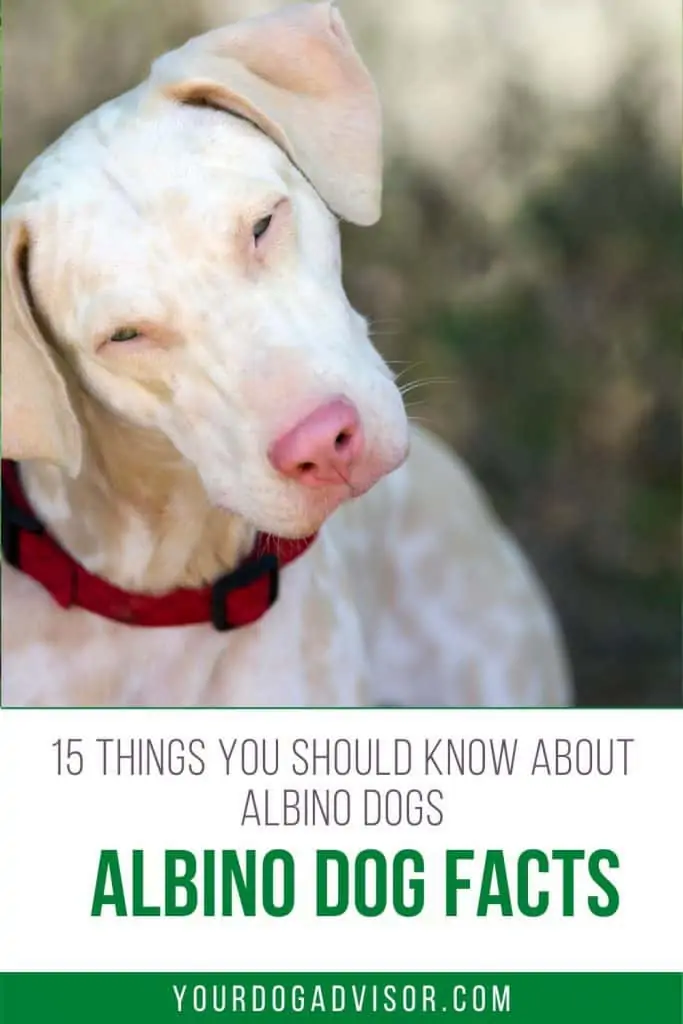

Jen Jones is a professional dog trainer and behavior specialist with more than 25 years of experience. As the founder of ‘Your Dog Advisor’ and the ‘Canine Connection’ rehabilitation center, she applies a holistic, empathetic approach, aiming to address root causes rather than merely treating symptoms.
Well known for her intuitive and compassionate approach, Jen adopts scientifically-proven, reward-based methods, encouraging positive reinforcement over punishment. Jen specializes in obedience training, behavior modification, and puppy socialization. Her innovative methods, particularly in addressing anxiety and aggression issues, have been widely recognized. Jen has worked with many of the world’s leading dog behaviorists and in her free time volunteers with local animal shelters and rescue groups.
